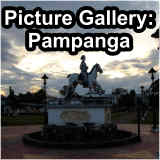

Landmarks in Pampanga:
Landmarks in Pampanga:
Landmark is a term that originated in the aviation and shipping. It referred to a situated
navigation marks (e.g. a lighthouse) or other conspicuous, usually highly visible
topographic object.
Since landmark is not an official title, we define it as follows:
A landmark is a typical characteristic or distinctive mark. It is characterized by the
geographical objects. These include primarily striking buildings as well as natural
features. According to our present knowledge, the most striking natural landmarks for
Pampanga are: The Pampanga River, Mt Arayat, Mount Pinatubo, Miyamit waterfalls,
Mega Dike and the Candaba Swamp.
A historical landmark marks a decisive moment in history (a moment of history on the
time line) and not necessarily the location of an event. Historical landmarks in
Pampanga are added to the Gallery “History in Pampanga”. In our definition, historical
landmark are: Fort Stotsenburg, the "Death march" markers which can be found in
some towns of Pampanga. The San Fernando Railway as the end of the “Death
March” before transporting the Filipino-American of war to Capas, Tarlac. The “the-
salakot-arch” and the “Bale Matua” (both in Angeles) and the Kamikaze Shrine in
Mabalacat. Cong Dadong Dam and Arayat National Park both in Arayat.
A Landmark can also be used to identify inhabited zones. Landmark which identifies an
"inhabited zone" in Pampanga will be added to the section Towns and Cities.
Landmarks, that we still want to especially emphasize here represent an action for the
particular zone: Hall of Heroes and the Monumento Fernandine in San Fernando. The
town mark in Minalin as a symbol of "hard work" as well as the solidarity and support
one another.


















Landmarks in Pampanga:
Landmarks in Pampanga:
Landmark is a term that originated in the aviation and shipping. It
referred to a situated navigation marks (e.g. a lighthouse) or other
conspicuous, usually highly visible topographic object.
Since landmark is not an official title, we define it as follows:
A landmark is a typical characteristic or distinctive mark. It is
characterized by the geographical objects. These include primarily
striking buildings as well as natural features. According to our present
knowledge, the most striking natural landmarks for Pampanga are:
The Pampanga River, Mt Arayat, Mount Pinatubo, Miyamit waterfalls,
Mega Dike and the Candaba Swamp.
A historical landmark marks a decisive moment in history (a
moment of history on the time line) and not necessarily the location of
an event. Historical landmarks in Pampanga are added to the Gallery
“History in Pampanga”. In our definition, historical landmark are: Fort
Stotsenburg, the "Death march" markers which can be found in some
towns of Pampanga. The San Fernando Railway as the end of the
“Death March” before transporting the Filipino-American of war to
Capas, Tarlac. The “the-salakot-arch” and the “Bale Matua” (both in
Angeles) and the Kamikaze Shrine in Mabalacat. Cong Dadong Dam
and Arayat National Park both in Arayat.
A Landmark can also be used to identify inhabited zones. Landmark
which identifies an "inhabited zone" in Pampanga will be added to the
section Towns and Cities.
Landmarks, that we still want to especially emphasize here represent
an action for the particular zone: Hall of Heroes and the Monumento
Fernandine in San Fernando. The town mark in Minalin as a symbol
of "hard work" as well as the solidarity and support one another.





































































